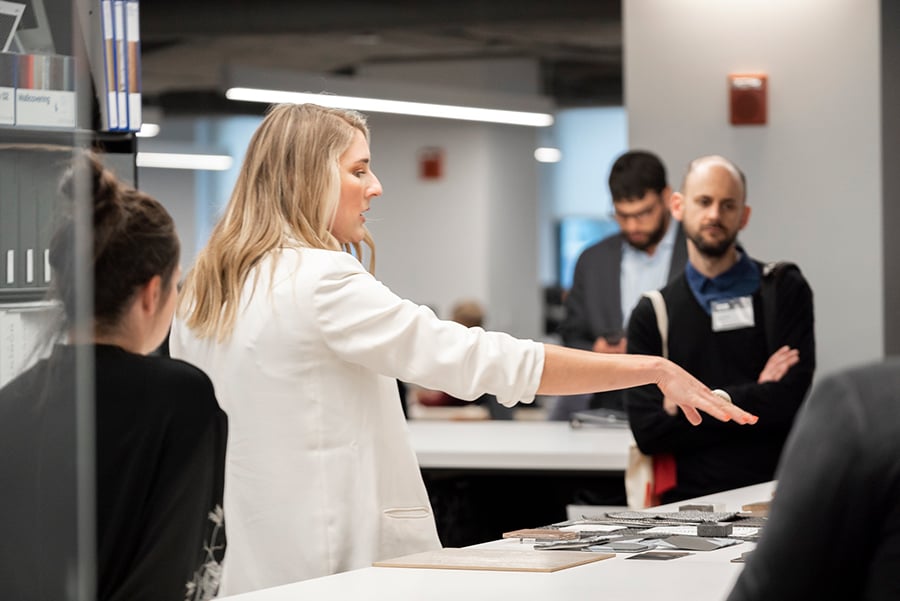
May 2, 2019
The Deep Value of Community Engagement in Urban Planning
At a recent Metropolis Think Tank in Chicago, architects and developers explored the immense benefits of crossing social and cultural boundaries when planning new neighborhoods.

A protracted real estate fight loomed over a recent Metropolis Think Tank event held at SmithGroup’s Chicago office. On the very day that panelists gathered to discuss reinventing and creating communities, the local city council approved a $6 billion mega-development in the North Side.
Lincoln Yards promises to transform a former industrial site into a mixed-use mini-high-rise district. On that day in early April, the city moved to confer public subsidies totaling $1.6 billion, a decision that followed in the wake of impassioned debates that highlighted the city’s need for more affordable housing and its duty to prevent the rupturing of neighborhoods that attend such wholescale developments. One of the panelists, Erin Lavin Cabonargi, a former executive with Lincoln Yard’s developer Sterling Bay, is a veteran of these disputes. She called Lincoln Yards “my baby for the last four years.”
But for the work of community building, four years isn’t very long. Again and again, panelists affirmed the need for monastic patience and obsessive listening. As the former executive director of Chicago’s Public Buildings Commission, panelist Lavin Cabonargi noted that there’s immense benefit to crossing social and cultural boundaries even when it slows things down. While working on a new library in the Chinatown neighborhood, many of her collaborators with the Chinese American Service League didn’t speak English, and the job required deep dives into culturally specific topics like feng shui. It ended up as “one of the most phenomenal interplays with the community that I’ve ever had the pleasure of working with,” recalled Cabonargi, who is currently managing director of Hibernian Advisors, a commercial real estate, infrastructure, and government affairs consultancy.

This kind of give-and-take obviates the now-quaint vision of the architect as lonely genius channeling mysterious inspiration. “Engagement and collaboration requires a different kind of architect,” observed SmithGroup’s Matt Dumich. “It’s about facilitating conversations and listening, which is a different way from [how] architects are used to working. The model of the architect with a cape is dead—the ‘master builder.’ Today we’re master collaborators.”
The panel shifted to Chicago’s South Side, where in the historic Pullman neighborhood architects and non-profits are called on to work with different groups (long-time residents and awaited tourists) with almost perfectly opposed priorities. A site of architectural, industrial, labor, and civil rights history, this former red brick company town built by railcar magnate George Pullman was declared a national monument in 2015, and the non-profit Chicago Neighborhood Initiatives (CNI) is working to channel this growth after decades of disinvestment. Within the next six or so years, “We’re expecting 300,000 visitors annually,” said Ciere Boatright of CNI. “That means that folks need somewhere to eat, they need hotels. When we think about diverse land uses, we’re thinking about all these things: housing, recreation, amenities, retail, industrial development, jobs. How do we make sure the folks that live there are benefitting from all the development?”
Perhaps most importantly, community members should feel listened to while they participate in the design and development process. The road out of systematic disinvestment experienced by many neighborhoods in Chicago’s South and West sides is long, Boatright pointed out. “Our work has been long-term, [so residents] hold us accountable. Our disinvested neighborhoods didn’t get this way in 10 years. It’s not going to take 10 years for them to revitalize all together.”
The Think Tank discussions were held on April 10 and 11, 2019, in Chicago. The conversations were presented in partnership with BIFMA, DXV/Grohe, KI, and Sunbrella Contract.
You may also enjoy “NYCxDesign 2019: How the Public Design Commission Encourages Better Design in NYC.”
Would you like to comment on this article? Send your thoughts to: [email protected]
Recent Viewpoints
Viewpoints
Sustainability News Updates for Q2 2025









